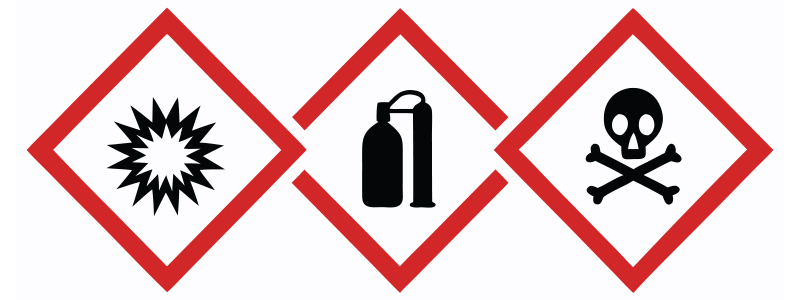5 Hidden GHS Rev. 7 Challenges Most Safety Leaders Overlook

When OSHA announced its update to the Hazard Communication Standard in May 2024, many companies saw it as just another regulatory adjustment. But if you're only thinking about labels and Safety Data Sheets (SDS), you're missing the bigger picture. The shift to align with GHS Revision 7 is a shift in how chemical safety must be managed across your entire operation.
For many, the hardest part won’t be understanding what changed. It will be understanding where those changes break existing systems. In this article, we’re looking at what’s really happening during this transition, the stuff that slips under the radar, and how modern solutions can help safety leaders stay ahead instead of scrambling to catch up.
What’s New in GHS Rev. 7
GHS Rev. 7 brings changes across hazard classification, labeling, and safety documentation. This includes:
New hazard categories like flammable gases 1A and 1B
Revised SDS sections, including physical and chemical properties
Updated pictograms and label formats for small containers
Expanded definitions for health effects, including respiratory hazards and germ cell mutagenicity
Knowing what changed is just the beginning. The real test comes when you try to apply those changes across outdated systems, scattered teams, and already stretched processes. That’s where the toughest challenges begin to surface.
Challenge 1: Outdated Classification Systems
Many companies still use legacy software or spreadsheets to manage hazard classifications. These systems aren't built to handle frequent regulatory changes. When hazard categories shift, like the new guidance on respiratory corrosives, those systems fall short. That can lead to misclassifications, missing hazard statements, or the wrong pictograms on your labels.
And those mistakes don’t just affect paperwork, they affect worker safety. Let’s say a company handles cleaning agents that release vapors. Under GHS Rev. 7, those vapors may be corrosive to the respiratory tract. The updated rule requires that risk to be labeled clearly, using both the corrosion pictogram and the correct hazard statement. Without a system that supports dual classification logic, that chemical might be labeled as either acutely toxic or simply corrosive, not both.

Challenge 2: SDS Overload
GHS Rev. 7 doesn’t just ask for cleaner formatting. It introduces new requirements in multiple SDS sections, including particle characteristics, revised concentration ranges, and new rules for trade secrets. If your SDS library lives in a static folder or scattered systems, keeping up will be an uphill climb.
This isn’t a one-time upload task. It’s an ongoing need for consistency across departments, facilities, and regions. Many companies struggle with version control. For example, when an updated SDS is created at one location but not rolled out globally, different branches could be referencing outdated safety data. That becomes a problem during inspections, and an even bigger problem during emergency response.
Challenge 3: Training That Doesn’t Stick
A big misconception? That one training session is enough. The reality is that frontline employees need ongoing, relevant microlearning to truly understand new hazards. Updates to label formats, pictograms, and SDS language only help if workers know what those changes mean on the job.
Without a plan for continuous learning, safety programs fall short, even if the documentation looks complete. Take the new pictogram guidance for small containers. If a worker sees a bottle without a pictogram because it’s under 3 mL, they may think the chemical is low-risk. Without proper training, they won’t realize the hazard information is on the secondary packaging, and they won’t look for it.
This becomes even more important in high-turnover environments, like hospitality or retail distribution, where new hires come on board regularly and seasonal staff may never receive follow-up training. Microlearning helps solve this. When workers get bite-sized, role-based training tied to their tasks and tools, they absorb it better, and apply it faster.
Challenge 4: Departmental Disconnects
Compliance isn't owned by one team. EHS might manage SDS. HR might manage training. Procurement might manage vendor safety data. If these teams use separate tools, important updates fall through the cracks. A reclassified chemical might never make it into employee training. A new SDS might not reach the right worksite.
The challenge isn’t just technical, it’s organizational. Let’s say a supplier updates an SDS and sends the new version to procurement. If that change isn’t shared with EHS, the safety team can’t verify the new hazards. If HR doesn’t know a retraining is needed, no one schedules it. If site managers aren’t notified, the new data never gets communicated to employees.
If each team is tracking their part of the process in separate spreadsheets or platforms, no one has the full picture. Fixing these disconnects doesn’t just take better communication, it takes a system that’s built to support it from the ground up.
How HSI Helps You Stay Ahead
GHS Rev. 7 compliance is about transforming how your organization handles chemical safety. Labels and SDS are only part of the equation. Real compliance requires coordination across systems, teams, and training programs.
That’s where HSI comes in. We don’t just offer software. We deliver a connected safety solution that works the way your teams actually operate, fast, flexible, and built to keep up with constant change.
Centralized SDS Management: No more scattered documents or version control issues. Our EHS System brings every SDS into one secure, searchable platform that updates in real time. Everyone, from site managers to field techs, gets the right information, when and where they need it.
Automated Hazard Classification: As regulations evolve, so do your classifications. Our system applies updates without the manual legwork, keeping your hazard data consistent and your workforce protected.
A Seamless EHS System + LMS: Training doesn’t exist in a vacuum. With our integrated platform, it connects directly to inspections, audits, and incident reports. That means fewer gaps, better tracking, and total compliance transparency.
Training That Fits Every Role: From onboarding to ongoing learning, you can deliver personalized training paths that match your people’s responsibilities. No more generic modules. Just relevant, role-specific content that actually sticks.
You’ve seen what GHS Rev. 7 demands. Now it’s time to equip your team with a system that actually supports them. Let’s simplify your compliance, strengthen your safety program, and help you stay ahead, today, tomorrow, and every day after. Contact HSI today.


